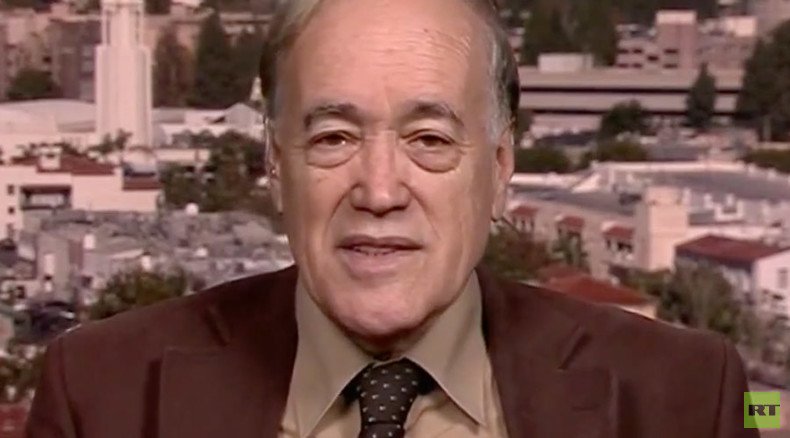‘Triple segregation’: Latinos more segregated in California schools now than 1970s – report

A UCLA report found Latinos in California attend schools that are 84 percent non-white, a 64 percent increase in segregation from the 1970s. The author of the report said Latinos face “triple segregation” and that integration is becoming more difficult.
“What’s…happened in California is a dramatic decline in white population as a share of the state, a huge increase in Latino population, and a major increase in Asian population, and a relatively stable black population,” UCLA Professor Gary Orfield, the author of the report, told RT.
“Even if you do nothing in terms of policy, segregation increases because the number of minorities increases and the number of white decreases, and the possibility of integration becomes more difficult.”
The initial findings came in a report that coincided with the 60th anniversary of the Brown v. Board of Education ruling that enforced racial integration in US schools. The report analyzed, among various trends, the diversity of schools in the 1970s and found a mix of 54 percent white students and 46 percent non-white students. Forty-four years later, white students account for just 16 percent of students, with 84 percent representing non-white students.
The report also found that over a period of two decades, from 1993-2013, black and Asian student enrollment in public schools remained fairly steady, while Latinos continued to dominate enrollment. In 1993 they represented 53 percent of all student enrollment in the state, and continued to do so in 2013. Meanwhile, white student enrollment dropped from 42 percent in 1993 to just 26 percent two decades later. Amid these changes in enrollment, Orfield said desegregation policy has also been affected.
“This has become all the more worse by dropping all the desegregation plans that existed in California up until the 1990s,” he told RT. “In California, there was a proposition adopted back in the 1980s that made it more difficult to integrate schools, and then the US Supreme Court in the 1990s adopted a policy of dissolving desegregation plans that had been in existence for a quite a while. So that was the end of the plans for San Jose, San Francisco and some other cities.”
Nearly 70 yrs after Mendez v Westminster, California remains the nation's most segregated for Latino students. https://t.co/8AKK9YxdT6
— The Broad Center (@BroadCenter) October 27, 2015He said for Latinos that this is triple segregation.
“It is segregation by their ethnic group, their social class, and by their language, because a lot of Latinos in California are in non-English speaking homes, and acquiring language is very difficult,” Orfield stated.
Orfield said if a student in the US is Asian or white, the chances are higher that the student attends a high school that really prepares them for a competitive college. Triple segregation for Latinos limits their access to college, so that if they attend community college and “come from highly segregated, high poverty high schools, they have much less success.”
1 in 5 US children live below poverty line, more than during Great Recession – report http://t.co/HKkngI7pBnpic.twitter.com/NFLH3aRMOh
— RT America (@RT_America) July 21, 2015The report also found that in 1993, black and Latino students attended schools where 52 percent and 58 percent of the children, respectively were poor, and no racial or ethnical group generally attended schools where a large majority of the students faced overwhelming poverty. By 2012, blacks, on average, attended schools that were two-thirds poor, and Latinos went to schools that were 70 percent poor, while whites and Asian students typically attended schools having a majority of middle-class students.
The most segregated districts they found were in Los Angeles – San Bernardino, with the most integrated in the Sacramento and Fresno areas.
The report, Segregating California’s Future: Inequality and Its alternative 60 years after Brown v. Board of Education, was published in May 2014.
“[Desegregation] is celebrated in the US. And it is known all over the world that our Supreme Court in 1954 in Brown v. Board of Education declared the racial systems of 17 of our states to be unconstitutional and set to work to begin to dismantling them,” Orfield said.
Poor by all means: Standard of living affects kids’ brain development – study http://t.co/E2So7QNxMQpic.twitter.com/Ei6hOXO1pM
— RT America (@RT_America) July 21, 2015During the Civil Rights period, the president, Congress, and the courts all worked to make that happen, and that huge progress was made, especially against the “absolute segregation” in the South, he said, adding that this had continued up until the Reagan years, when “it turned in the opposite direction.”
“People don’t know that because they are … taught about the successes … they really don’t talk about the conservative counter-revolution that dismantled many of those successes.”












